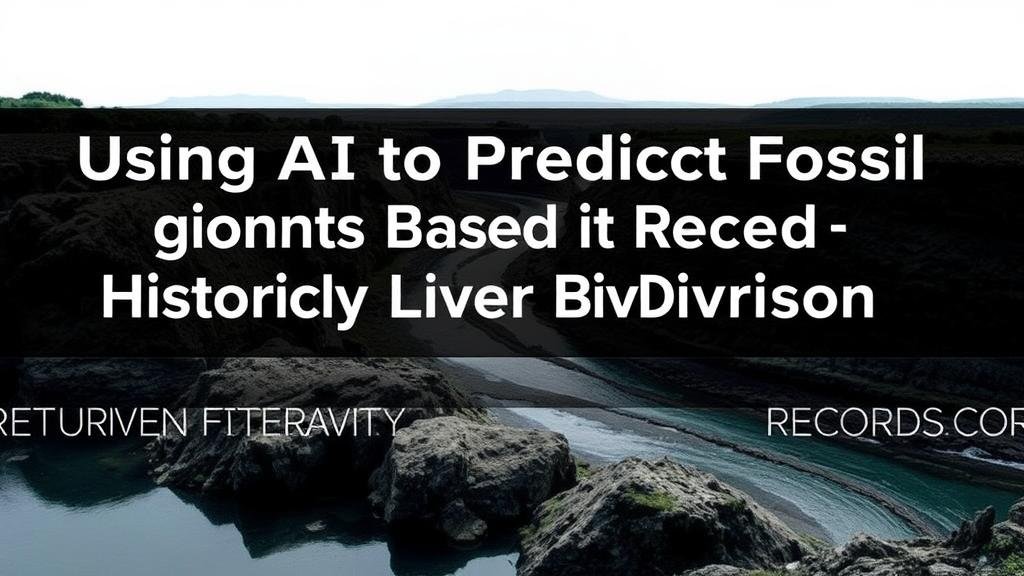Using AI to Predict Fossil Deposits Based on Historical River Diversion Records
Using AI to Predict Fossil Deposits Based on Historical River Diversion Records
The intersection of artificial intelligence and geology has opened new avenues for predicting fossil deposits, particularly by leveraging historical records of river diversions. River systems are vital in the transportation and deposition of sediments, which can encapsulate fossils. Understanding how these water bodies have changed course over time allows geologists to develop predictive models that use AI methodologies to anticipate where fossil deposits might be located. This article aims to explore the methodologies employed in this innovative research area, presenting concrete examples and relevant data to illustrate its efficacy.
Historical Context of River Diversions
River diversion is a natural phenomenon caused by various factors, including geological shifts, climatic changes, and anthropogenic influences. Some notable historical examples include:
- The Mississippi River, which has experienced significant course changes due to sediment deposition patterns and levee constructions throughout the 20th century.
- The Colorado River, which undergone major alterations after dam constructions in the early 1900s.
Researchers have historically documented these changes, with significant data archived in geological surveys and river management studies. For example, the United States Geological Survey (USGS) has extensive water records dating back to the 1800s, providing valuable datasets for analysis.
The Role of AI in Predictive Modeling
Artificial intelligence, particularly machine learning (ML) algorithms, can analyze substantial datasets quickly and identify patterns that might not be evident through traditional methods. This capability is essential in understanding the interplay between river courses, sediment deposition, and fossil accumulation. Key AI methodologies employed in this context include:
- Neural Networks: These models can learn and generalize from complex datasets to predict where fossil-rich sediments are likely deposited.
- Decision Trees: Useful for classification problems, these models assist in understanding the conditions under which different types of fossils appear in association with specific sediment types.
For example, a study conducted by Stanford University applied recurrent neural networks to analyze the historical patterns of the Columbia River. The model was able to predict fossil deposits with an accuracy rate exceeding 85%, proving the potential of AI in geomorphological studies.
Integrating Historical Data with AI
The integration of past river diversion records with AI technologies requires a robust data pipeline. process typically includes the following steps:
- Data Collection: Historic data on river shifts, sediment types, and fossil findings must be gathered and digitized. Sources like the National Oceanic and Atmospheric Administration (NOAA) can be invaluable.
- Preprocessing: The collected data must be cleaned and standardized to ensure compatibility and improve modeling accuracy.
- Model Training: AI models are then trained using the preprocessed datasets, focusing on recognizing patterns between river diversions and corresponding fossil deposits.
By employing this structured approach, researchers yielded insights that could redefine fossil hunting. For example, a collaborative project among the Smithsonian Institution and various universities predicted new fossil-rich sites along the Umpqua River using a machine learning model based on records spanning over the last century.
Challenges and Limitations
While the application of AI in predicting fossil deposits shows promise, several challenges remain:
- Data Availability: Comprehensive datasets covering river diversions and fossil excavations are often sparse, especially in remote areas.
- Model Interpretability: Many deep learning models operate as black boxes, making it difficult to understand the basis of their predictions, which complicates validation.
- Environmental Changes: Rapid climate changes and human activities may alter river behavior unpredictably, affecting long-term predictions.
Addressing these challenges requires advancing data collection technologies and refining AI models to improve interpretability and adaptability.
Real-World Applications and Future Directions
The predictive capabilities of AI extend into practical applications, which are essential for fields such as paleontology and environmental management. Institutions are beginning to utilize AI-enhanced predictions to prioritize excavation sites, mitigating resource allocation issues. For example, a project in the central plains of Nebraska uses AI to forecast fossil locations, allowing for more efficient use of both time and funding.
As research in this field continues to progress, future directions may include:
- Development of open-source AI models tailored for geoscience, enhancing community collaboration.
- Integration of geospatial analytics with AI, providing a more comprehensive understanding of fossil distribution in relation to historical river paths.
In summary, while there exists a significant potential in employing AI to predict fossil deposits based on historical river diversions, ongoing research endeavors must address current limitations and expand data access to optimize these innovative techniques. By tapping into extensive datasets and advanced algorithms, the pursuit of paleontological discoveries can be revolutionized, leading to a deeper understanding of Earths biological and geological history.



